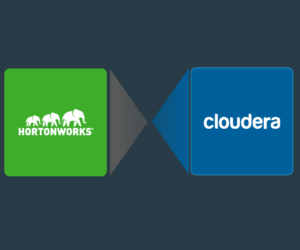
Merger with Hortonworks Complete, Cloudera Looks to Future

Cloudera and Hortonworks completed their merger today, becoming the preeminent software supplier in the Hadoop ecosystem and possibly the second largest open source software vendor. Flush with half a billion dollars in cash and no debt, the new Cloudera says it’s primed to deliver solutions that map to its new tagline: From the edge to AI.
Cloudera and Hortonworks shocked the big data ecosystem last October when the two rivals announced plans to lay down arms and merge their operations to create a single entity focused on building out the Hadoop platform and adjacent solutions. Instead of spending hundreds of millions of dollars to build, sell, and service software that is largely similar, the two parties decided to join forces and confront their common enemy: Amazon Web Services.
While the two companies jockeyed for position in the open source Apache Hadoop community and competed fiercely to sell commercial solutions based on that software, they also carved out specific niches that they now claim will give the new Cloudera an advantage in the emerging distributed computing paradigm. For its part, Cloudera says its accomplishments in machine learning prepared it for the coming AI demands. Meanwhile, Hortonworks claims its investments in data ingest and real-time streaming, as manifest in its NiFi product offering, gave it an edge in that department.
Mike Olson, a Cloudera co-founder and its chief strategy officer, sounded upbeat in his assessment of Cloudera’s future in a blog post published today.
“We are at scale — more than $720M in trailing twelve-month revenue and growing — with more than half a billion dollars in cash, and no debt,” Olson writes. “Our pre-merger customer bases have very little overlap, giving us a considerable enterprise installed base whose demand for IoT, analytics, data warehousing, and machine learning continues to grow. I can’t think of a comparable enterprise software transaction in my thirty years in the industry.”
Hortonworks co-founder Arun Murthy has arguably the most visible role of any Hortonworks executive in the new Cloudera reporting structure. As Cloudera’s new chief product officer, Murthy will be instrumental in leading the work to merge the two product bases into a single entity, which the vendors dubbed the “Unity” release.
But beyond rationalizing various parts of the Cloudera Distribution of Hadoop (CDH) and Hortonworks Data Platform (HDP) stacks into a single strategic platform, the company is also looking to project power and bolster its bona fides in the emerging enterprise requirement for data platforms to run in a hybrid manner and across multiple clouds.
“Cloudera is now the only data management company to run across all major public cloud infrastructures: AWS, Azure, Google, IBM and Oracle,” Murthy writes in a blog post today. “And because we’ve invested so consistently and heavily in engineers and committers in the open-source community, we’ll be able to fuel innovation faster than we could have achieved as standalone companies.”
The crux of Cloudera’s new strategy hinges on its capability to deliver hybrid big data storage and processing capabilities that the cloud vendors cannot – at least not until AWS’ hybrid partnership with Dell EMC, which it announced at the 2018 re:Invent conference last month, starts to bear fruit.
“We expect to transform the enterprise data center, delivering a public-cloud experience in-house, ensuring that workloads can migrate to where they make the most sense to run and eliminating cloud vendor lock-in,” Olson writes. “We’ll do this with more people, a stronger balance sheet and a much larger customer base to learn from.”
The new Cloudera’s “cloud everywhere” approach has received nods of approval from some influential folks in the industry, including Forrester analyst Noel Yuhanna, who wrote in October that the merger “will raise the bar on innovation in the big data space, especially in supporting an end-to-end big data strategy in a hybrid and multi-cloud environment. We believe that it’s a win-win situation for customers, partners, and the vendors.”
While the new Cloudera is arguably stronger and better positioned than either pre-merger company, there are macro-economic challenges that could slow growth. For starters, the fourth quarter market downturn (meltdown?) has shrunk the value of the two vendors by quite a bit. At the time of the announcement the combined shareholder equity of the two companies stood at $5.2 billion. As of Wednesday, Cloudera’s market capitalization was $1.59 billion and Hortonworks’ was $1.24 billion.
Neither company has had to weather an economic recession. Cloudera, which was incorporated in 2008, launched its first offering in March 2009, the nadir of the Great Recession and the start of the nearly 10-year bull market. Hortonworks, meanwhile, emerged from Yahoo in 2011 and has also enjoyed rising IT spending that’s been fueled by the big data boom and an explosion of distributed computing technologies and disruptive business models.
Cloudera CEO Tom Reilly, GM of Machine Learning Hilary Mason, and Murthy will host a virtual event next Thursday January 10 at 10 a.m. PT to discuss its Edge to AI strategy. You can register for the event here.
Related Items:
New Cloudera Plots a Course Toward a Unified Future
Cloudera and Hortonworks to Merge in $5.2 Billion Deal




























